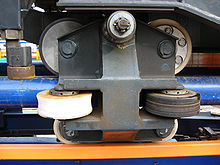
On a roller coaster, the wheel assemblies are the point of contact between the cars carrying the riders and the track rails. They often consist of at least 3 wheels per assembly, but can contain more.
The typical arrangement of the wheels are:
- Running wheels (also known as road wheels or tractor wheels): positioned on the top of the rail, bearing the weight of the train.
- Side friction wheels: positioned on a horizontal plane, either inside or outside of the rails. These hug the sides of the rail, keeping the train centered.
- Up-stop wheels (also known as underfriction wheels or up-lift wheels): positioned under the rails to keep the train from lifting off of the track.
Design
On modern roller coasters, both wooden and steel, the same basic design of wheel assembly is found. Each wheel assembly typically consists of at least 3 wheels per assembly arranged in 3 positions: top, side, and under the rails, known as "road wheels", "guide wheels", and "up-stop wheels", respectively. Most modern roller coasters typically have pairs of wheels in each orientation, with 6 wheels per assembly, but this can vary by ride. The up-stop system was developed in 1919 by John A. Miller. He patented a design to make Pleasure-Railway attractions safer. His design consisted of wheels underneath the rails, keeping the train on the track rather than relying on gravity, which allowed more aggressive inclines and a more thrilling ride.
Most roller coasters have some form of up-stop system that runs underneath the rails. They are commonly wheels, but some older roller coasters or low-intensity, family focused rides may utilize a steel plate or bar positioned under the rails due to low forces. Up-stop wheels keep the train from lifting off of the track while traversing hills that may provide negative g-forces, or through inversions. They are typically the smallest wheels out of the assembly.
Side friction wheels hug the sides of the rail, either the outside or inside, depending on the ride manufacturer. Early Arrow Dynamics steel roller coasters oriented the side frictions wheels on the inside of the rails. Side friction wheels keep the train centered in the track, avoiding derailment.
The final set of wheels in the assembly are known as running wheels, road wheels, or tractor wheels. Running wheels are typically the largest set of wheels in the assembly, and roll on the top of the rails. These wheels bear the weight of the train. They are typically made from a polyurethane or nylon/polyurethane blend, while side friction and up-stop wheels can be made of the same materials or steel. Some older wooden roller coasters utilize steel wheels throughout the assembly. The benefits of the polyurethane or nylon/polyurethane blend are low rolling resistance, high load endurance, smooth ride, and high durability.
Some manufacturers' coasters have a larger gap between the up-stop and/or side friction wheels and the track. In instances of negative g-force or through inversions, the road wheels may lift off the track slightly until the up-stop wheels engage. This can result in a rougher ride. As technology has improved, the gap has been significantly lessened or eliminated, resulting in smoother rides.
Variations & examples
Wheel assemblies vary from manufacturer to manufacturer, and from ride to ride. Some models, such as Arrow Dynamics corkscrews, orient their side friction wheels on the inside of the rails rather than outside. Wooden roller coasters also utilize the interior side friction orientation.
On inverted roller coasters, such as those produced by Swiss manufacturer Bolliger & Mabillard, the wheel assemblies are typically in the same configurations, despite the cars being positioned below the track. These wheel assemblies typically feature some form of cover or shielding to protect riders from any debris or fluids kicked up by the wheels from above.
Some roller coasters utilize unique wheel configurations:
- On Superman: Escape from Krypton, manufactured by Intamin, located at Six Flags Magic Mountain, the cars do not use typical side friction wheels along the rails, but rather uses a thin steel rail mounted in the center of the track to keep the train centered, while running and up-stop wheels roll along the outer rails. Before its 2010 refurbishment, which introduced new cars, the cars had much larger than average running wheels, which partially contributed to the ride's infamous loud roar. The cars on the now defunct Tower of Terror II in Dreamworld, Australia used a similar design.
- On X2, also located at Six Flags Magic Mountain, the trains utilize 4 rails, rather than the usual 2, in order to rotate the seats. With this configuration, the cars have 6 wheels per assembly running on the main rails, and an additional 4 wheels per side running on the extra set of rails.
- On flying roller coasters, such as those produced by Bolliger & Mabillard and Vekoma, the running wheels and up-stop wheels are typically the same size due to the trains upright orientation switching throughout the ride.
Gallery
-
 Wheel assemblies on the B&M flying coaster, Superman Ultimate Flight. Note the same-sized running and up-stop wheels, a common configuration on flying coasters.
Wheel assemblies on the B&M flying coaster, Superman Ultimate Flight. Note the same-sized running and up-stop wheels, a common configuration on flying coasters.
Notes
- "Roller Coaster Wheels | Precision Engineered | UK's largest stockist". www.technicawheels.co.uk. Retrieved 2023-04-29.
- "Roller Coaster Wheels | Precision Engineered | UK's largest stockist". www.technicawheels.co.uk. Retrieved 2023-04-29.
| Roller coasters | ||
|---|---|---|
| Overview | ||
| Technology | ||
